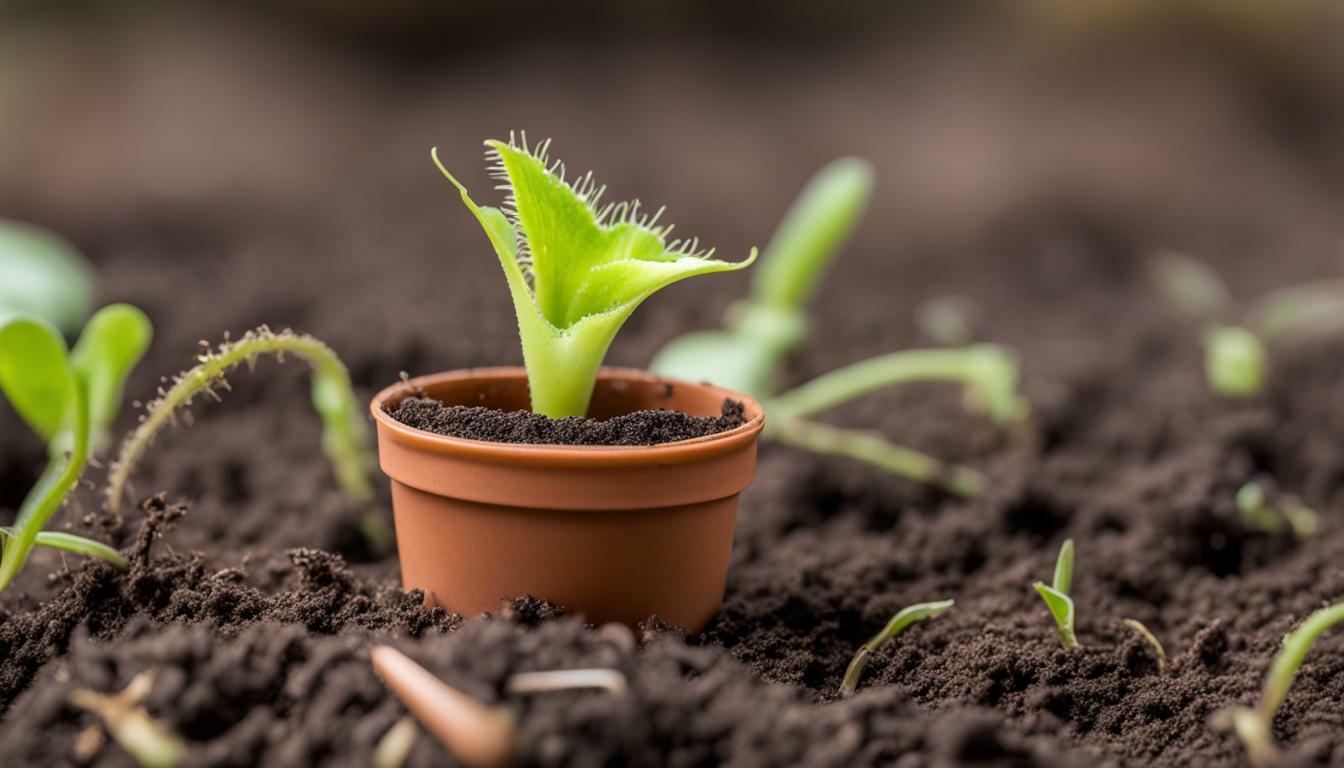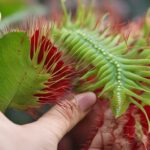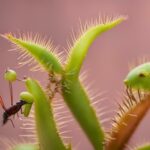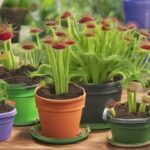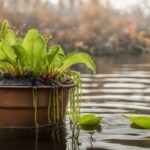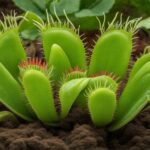If you’re a fan of carnivorous plants, you may have wondered if Venus flytraps can be grown from seeds. The answer is yes, and in this guide, we will take you through the steps required to successfully grow Venus flytraps from their seeds.
While growing Venus flytraps from seeds can be a bit more challenging than propagating them from cuttings, it’s a rewarding process that allows you to experience the full life cycle of these fascinating plants.
Key Takeaways
- Yes, Venus flytraps can be grown from seeds.
- Growing Venus flytraps from seeds can be more challenging than propagating them from cuttings.
- With proper knowledge and care, you can successfully germinate the seeds, care for the seedlings, and enjoy the beauty of these captivating plants.
Understanding Venus Flytrap Seeds
Before you start growing Venus flytraps from seeds, it’s important to understand the characteristics of the seeds and how to properly handle them. Venus flytrap seeds are tiny and delicate, and can easily be damaged if mishandled.
The best time to start growing Venus flytrap seeds is in the early springtime, as these plants require a period of cold dormancy before they can germinate. You can purchase Venus flytrap seeds from nurseries or online suppliers. Make sure to buy from a reliable source to ensure you get high-quality seeds.
How to Start Venus Flytrap Seeds
The first step in starting Venus flytrap seeds is to moisten the growing medium. You can use sphagnum moss, peat moss, or a mixture of both as the growing medium, and add water until it’s thoroughly moistened. Be careful not to soak the medium, as seeds can rot in waterlogged soil.
Next, plant the seeds in the growing medium. You can sprinkle the seeds on top of the soil, or use a toothpick to carefully place them into the soil. Cover the seeds with a thin layer of the growing medium, around a quarter of an inch deep.
After planting, cover the container with a plastic wrap or a plastic lid to create a greenhouse-like environment. This will help to keep the moisture levels high and maintain warmth. Place the container in a warm, well-lit spot, but out of direct sunlight.
It’s important to keep the growing medium moist during the germination process. You can mist the growing medium with a spray bottle or add water to the tray below the container, but be careful not to overwater. Too much moisture can cause the seeds to rot.
Caring for Venus Flytrap Seedlings
Once the seeds have germinated and the seedlings have emerged, remove the plastic wrap or lid. Venus flytrap seedlings require bright, indirect sunlight, between 12-16 hours per day. You can use a grow light if you don’t have access to natural sunlight.
Keep the soil moist, but not waterlogged, throughout the growing process. You can water the seedlings by placing the container in a tray of water and allowing the soil to soak up the water from the bottom. Avoid getting water on the leaves, as it can cause damage to the sensitive hairs.
Venus flytrap seedlings also require high humidity levels, between 50-60%. You can increase the humidity levels by covering the container with a plastic dome or a clear plastic bag. Make sure to leave some ventilation to prevent mold and fungi from forming.
As the seedlings grow, you can slowly decrease the humidity levels and increase the amount of sunlight they receive. After a year, the seedlings should be large enough to transplant into their permanent containers.
The Process of Germinating Venus Flytrap Seeds
Growing Venus flytraps from seeds is a fascinating and rewarding experience. However, the process can be tricky and requires a bit of patience and attention to detail. Follow these steps to successfully germinate Venus flytrap seeds:
- Preparing the materials: Before you start the germination process, you will need a few items, including Venus flytrap seeds, a growing medium, a container with a lid, and distilled or rainwater. The growing medium should consist of a 50:50 mixture of peat moss and silica sand.
- Preparing the seeds: Venus flytrap seeds need to be fresh to germinate successfully. If you are using seeds that are more than a year old, their germination rate will likely be low. Before planting the seeds, you can pretreat them by soaking them in a solution of 10% hydrogen peroxide and 90% distilled water for about 5 minutes. This will help to disinfect the seeds and improve their chances of germination.
- Planting the seeds: Once you have prepared the materials and the seeds, you can start planting. Fill the container with the growing medium and moisten it with distilled or rainwater. Then, scatter the seeds on top of the medium, making sure they are evenly distributed. Don’t cover the seeds with the growing medium as they require light to germinate. Cover the container with a lid to create a humid environment and place it in a warm, bright location out of direct sunlight.
- Caring for the seeds: During the germination process, it’s crucial to keep the growing medium moist but not overly wet. You can water the seeds by placing the container in a tray of water for a few minutes, allowing the water to seep into the medium from the bottom. Avoid misting the seeds with water as this can lead to fungal growth. Check the container regularly and remove any condensation that may have formed on the lid to prevent mold from developing.
- Growing the seedlings: After about 4-6 weeks, the seeds should start to germinate, and tiny Venus flytrap seedlings will emerge from the growing medium. At this point, you can remove the lid from the container and place the seedlings in a bright location with direct sunlight for 4-6 hours a day. The seedlings will require a high level of humidity, so mist them occasionally with distilled or rainwater. After a few months, the seedlings will start to develop their characteristic traps.
Germinating Venus flytrap seeds can be a challenging but rewarding process. By following the steps outlined above, you can successfully grow your own Venus flytrap plants from seeds.
Caring for Venus Flytrap Seedlings
Once your Venus flytrap seeds have germinated, it’s essential to provide the right conditions to ensure their healthy growth. These delicate seedlings require attentive care, including proper light, water, and nutrient levels.
| Light | Venus flytrap seedlings require bright, indirect light to thrive. Avoid placing them in direct sunlight, as this can scorch their delicate leaves. A south-facing window with a sheer curtain is an ideal location. |
|---|---|
| Water | Seedlings should be kept consistently moist, never allowing the soil to dry out completely. Water them with distilled or rainwater, as tap water can contain minerals that are harmful to the plant. |
| Nutrients | Venus flytrap seedlings do not need fertilizer until they have been growing for several months. When it’s time to fertilize, use a low-nitrogen, high-potassium formulation diluted to half strength. |
As your seedlings grow, they will eventually outgrow their small starter pots and require repotting. This is best done in the spring, before the start of the growing season. Use a mixture of sphagnum peat moss and perlite for the best soil composition.
With proper care, your Venus flytrap seedlings will grow into healthy and thriving plants, ready to take on insects and other small prey with their unique trapping mechanisms.
Propagating Venus Flytraps from Seeds
Did you know that you can grow new Venus flytrap plants from the seeds you’ve germinated? Propagating Venus flytraps from seeds is a fun and affordable way to expand your plant collection. Here’s how to do it:
- Allow the seedlings to grow until they have at least 4-6 mature leaves.
- Gently remove the entire plant from the soil, making sure the roots are intact.
- Divide the plant into smaller sections, making sure that each section has a small portion of the root system.
- Plant each new section in a small pot filled with fresh, well-draining soil.
- Water each new plant thoroughly and place them in a bright, sunny location.
Using this method, you can create several new plants from one batch of Venus flytrap seeds. It’s important to note that it may take up to a year for the new plants to mature and produce traps, so be patient.
By following these simple steps, you can successfully propagate Venus flytraps from seeds and enjoy a thriving collection of these fascinating plants.
Tips for Successful Seed Germination
If you want to grow Venus Flytraps from seeds, it’s important to understand that germinating them can be a bit tricky. Here are some tips to increase your success rate:
- Use Fresh Seeds: Venus Flytrap seeds don’t stay viable for very long, so it’s important to use fresh seeds to ensure successful germination.
- Provide Proper Light: Venus Flytrap seeds need bright, indirect light to germinate. Do not expose them to direct sunlight as it can be too intense for them.
- Use the Right Soil Mix: Venus Flytrap seeds need a well-draining soil mix, such as a 50/50 combination of peat moss and perlite. Avoid using regular potting soil.
- Maintain Proper Humidity: Venus Flytrap seeds need a high level of humidity to germinate. A humidity dome or plastic wrap can help to maintain the necessary moisture levels.
- Keep the Soil Moist: Venus Flytrap seeds need to be kept consistently moist during the germination process. Be careful not to overwater or let the soil dry out completely.
- Be Patient: Venus Flytrap seeds can take several weeks to germinate, so be patient and don’t give up. Continue to provide optimal growing conditions and wait for the magic to happen!
Following these tips can significantly increase your chances of successfully growing Venus Flytraps from seeds. Remember that this is a delicate process that requires attention to detail and patience. But with the right approach, you can enjoy the reward of growing your own Venus Flytrap from a tiny seed.
Common Challenges and Troubleshooting
Growing Venus flytraps from seeds can be a rewarding experience, but it may come with some challenges that you need to address. Here are some common issues you may encounter and how to troubleshoot them.
Slow or No Germination
If you find that your Venus flytrap seeds are slow to germinate or not germinating at all, there are a few things you can do. First, make sure that you are using high-quality seeds from a reputable source. Next, check your planting conditions, including soil quality, temperature, and humidity. Venus flytrap seeds require specific conditions to germinate, including a moist environment and temperatures between 70 and 85 degrees Fahrenheit.
If you have addressed these factors and still experience slow or no germination, you may need to adjust your planting method. Some growers have found success with a cold stratification process, which involves placing the seeds in a moist environment in the refrigerator for several weeks before planting.
Seedling Damping Off
Seedling damping off is a fungal disease that can affect Venus flytrap seedlings, causing them to wilt and die. To prevent damping off, make sure that your planting containers and soil are sterilized before planting. Avoid overwatering the seedlings, as excess moisture can promote fungal growth.
If you notice signs of damping off, remove the affected seedlings immediately and adjust your watering habits. You may also want to consider using a fungicidal treatment to prevent further spreading.
Weak or Leggy Seedlings
Weak or leggy seedlings can be caused by a lack of light or poor growing conditions. Make sure that your seedlings are receiving adequate sunlight or artificial light, as well as proper watering and soil conditions.
You may also need to thin out your seedlings to prevent overcrowding, which can lead to weak growth. If your seedlings are still weak despite these adjustments, you may need to consider starting over with fresh seeds.
Yellowing Leaves
Yellowing leaves can be a sign of nutrient deficiencies or overwatering. Make sure that you are using a balanced fertilizer and not overwatering your plants. If your soil is compacted, it may be preventing proper nutrient absorption, requiring the addition of perlite or sand to help improve drainage.
It’s also important to note that Venus flytraps naturally shed their leaves as they grow, so occasional yellowing may not necessarily indicate a problem.
By addressing these common challenges and troubleshooting tips, you can ensure healthy growth and successful propagation of your Venus flytrap seedlings.
Conclusion
After reading this guide, you now know that Venus flytraps can indeed be grown from seeds. With the right knowledge and care, you can successfully germinate the seeds, care for the seedlings, and enjoy the unique beauty of these fascinating plants in your own home.
So, can Venus flytraps be grown from seeds?
Yes, they can be! Whether you’re a beginner gardener or a seasoned plant enthusiast, growing Venus flytraps from seeds is a rewarding and exciting experience. By following the steps outlined in this guide, you can successfully propagate these captivating plants in your own home.
Remember, the key to successful germination and growth is to provide your Venus flytraps with the right conditions, including proper lighting, humidity levels, and watering. With patience and attention to detail, you can watch these unique plants thrive and flourish.
So go ahead and give it a try – you’ll be amazed at just how easy it is to grow your own Venus flytraps from seeds!
What Nutrients Do Venus Flytraps Require for Successful Growth?
Venus Flytraps, fascinating carnivorous plants, have specific nutrient needs for thriving growth. Fertilizing a venus flytrap: a plant nutrition guide is essential to understand their requirements. These plants primarily rely on a combination of sunlight, soil, and insects for sustenance, but they can benefit from occasional fertilization. Supplying them with a diluted, low-nitrogen fertilizer during the growing season can aid in their overall health and vigor. However, it’s crucial to exercise caution as over-fertilization can harm these unique plants.
FAQ
Q: Can Venus flytraps be grown from seeds?
A: Yes, Venus flytraps can be grown from seeds. It requires the right knowledge and care to successfully germinate the seeds and care for the seedlings.
Q: What are some tips for successful seed germination?
A: To improve your success rate when germinating Venus flytrap seeds, make sure to provide the right conditions such as moist soil, bright light, and a warm environment. Additionally, stratifying the seeds before planting can help break dormancy.
Q: How do I care for Venus flytrap seedlings?
A: Venus flytrap seedlings require a high humidity environment, ample sunlight, and distilled water. Avoid fertilizing them initially and provide proper ventilation to prevent fungal infections.
Q: Can I propagate Venus flytraps from seeds?
A: Yes, you can propagate Venus flytraps from seeds. Once the seeds have successfully germinated, you can create new plants by carefully dividing the clumps of seedlings.
Q: What are the common challenges when growing Venus flytraps from seeds?
A: Common challenges include improper germination due to incorrect environmental conditions, fungal infections, and poor seedling growth. By following the proper care guidelines, you can overcome these challenges.
Q: How long does it take for Venus flytrap seeds to germinate?
A: Venus flytrap seeds typically take anywhere from 2 to 8 weeks to germinate, depending on the environmental conditions and seed quality.

